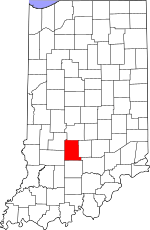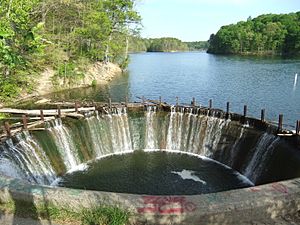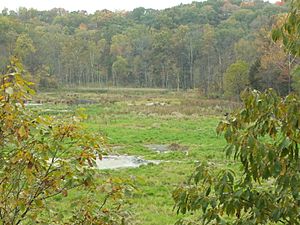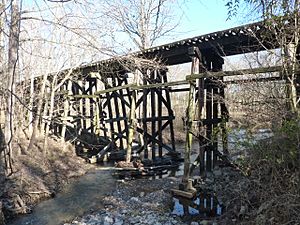Monroe County, Indiana facts for kids
Quick facts for kids
Monroe County
|
||
|---|---|---|

Monroe County courthouse in Bloomington, Indiana
|
||
|
||

Location within the U.S. state of Indiana
|
||
 Indiana's location within the U.S. |
||
| Country | ||
| State | ||
| Founded | 14 January 1818 | |
| Named for | James Monroe | |
| Seat | Bloomington | |
| Largest city | Bloomington | |
| Area | ||
| • Total | 411.32 sq mi (1,065.3 km2) | |
| • Land | 394.51 sq mi (1,021.8 km2) | |
| • Water | 16.81 sq mi (43.5 km2) 4.09%% | |
| Population | ||
| • Estimate
(2019)
|
148,431 | |
| • Density | 372.4/sq mi (143.8/km2) | |
| Time zone | UTC−5 (Eastern) | |
| • Summer (DST) | UTC−4 (EDT) | |
| Congressional district | 9th | |
| Indiana county number 53 | ||
Monroe County is a county in the U.S. state of Indiana. In 1910 the US Census Bureau calculated the nation's mean population center to lie in Monroe County. The population was 137,974 at the 2010 United States Census. The county seat is Bloomington. Monroe County is part of the Bloomington, Indiana, Metropolitan Statistical Area.
Contents
History
Monroe County was formed in 1818 from portions of Orange County. It was named for James Monroe, fifth President of the United States, who was serving at the time the county was organized.
Geography
According to the 2010 census, the county has a total area of 411.32 square miles (1,065.3 km2), of which 394.51 square miles (1,021.8 km2) (or 95.91%) is land and 16.81 square miles (43.5 km2) (or 4.09%) is water.
Bodies of water
Monroe County is divided between the basins of the East Fork and West Fork of Indiana's White River. The southern part of the county drains to the East Fork, primarily via Salt Creek and its tributaries, such as Clear Creek (known as "Jordan River" on Indiana University Bloomington campus). The northern part drains to the West Fork.
Several artificial reservoirs have been constructed by damming the county's creeks. The largest of them is Lake Monroe, a large reservoir on the Salt Creek in the south-eastern part of the county, is used both for recreational purposes and to supply the city with drinking water. Until the late 1960s, the main source of water supply was the smaller Lake Lemon (constructed 1953), in the northeastern part of the county; now it's the backup water source, and is mainly used for recreation.
The third in order of size is Griffy Lake, on the northern slope of the county. Constructed in 1924 by damming Griffy Creek, it was Bloomington's main water source until 1954; now it is now primarily used recreationally, although there are arrangements for it to be used as an emergency water source as well. An even smaller Weimer (Wapehani) Lake in the Clear Creek basin was originally constructed for water supply purposes as well, but now is used purely for recreation (fishing).
A number of former limestone quarries in the county are now naturally filled with water, as featured in the 1979 film Breaking Away.
National protected areas
- Hoosier National Forest (part)
Natural wonders
- Buckner Cave
- Leonard Springs Nature Park, where the waters of Sinking Creek reappears in springs
Communities
Cities
Towns
Census-designated places
Other unincorporated places
Townships
- Bean Blossom
- Benton
- Bloomington
- Clear Creek
- Indian Creek
- Perry
- Polk
- Richland
- Salt Creek
- Van Buren
- Washington
Climate and weather
| Weather chart for Bloomington, Indiana | |||||||||||||||||||||||||||||||||||||||||||||||
|---|---|---|---|---|---|---|---|---|---|---|---|---|---|---|---|---|---|---|---|---|---|---|---|---|---|---|---|---|---|---|---|---|---|---|---|---|---|---|---|---|---|---|---|---|---|---|---|
| J | F | M | A | M | J | J | A | S | O | N | D | ||||||||||||||||||||||||||||||||||||
|
2.7
36
19
|
2.7
42
23
|
3.7
52
32
|
4.3
64
41
|
5.1
74
52
|
4.1
82
61
|
4.3
86
65
|
4
84
62
|
3.6
78
55
|
3.1
67
44
|
4
54
35
|
3.4
41
24
|
||||||||||||||||||||||||||||||||||||
| temperatures in °F precipitation totals in inches source: The Weather Channel |
|||||||||||||||||||||||||||||||||||||||||||||||
|
Metric conversion
|
|||||||||||||||||||||||||||||||||||||||||||||||
In recent years, average temperatures in Bloomington have ranged from a low of 19 °F (−7 °C) in January to a high of 86 °F (30 °C) in July, although a record low of −21 °F (−29 °C) was recorded in January 1985 and a record high of 110 °F (43 °C) was recorded in July 1936. Average monthly precipitation ranged from 2.66 inches (68 mm) in January to 5.12 inches (130 mm) in May.
Demographics
| Historical population | |||
|---|---|---|---|
| Census | Pop. | %± | |
| 1820 | 2,679 | — | |
| 1830 | 6,577 | 145.5% | |
| 1840 | 10,143 | 54.2% | |
| 1850 | 11,286 | 11.3% | |
| 1860 | 12,847 | 13.8% | |
| 1870 | 14,168 | 10.3% | |
| 1880 | 15,875 | 12.0% | |
| 1890 | 17,673 | 11.3% | |
| 1900 | 20,873 | 18.1% | |
| 1910 | 23,426 | 12.2% | |
| 1920 | 24,519 | 4.7% | |
| 1930 | 35,974 | 46.7% | |
| 1940 | 36,534 | 1.6% | |
| 1950 | 50,080 | 37.1% | |
| 1960 | 59,225 | 18.3% | |
| 1970 | 84,849 | 43.3% | |
| 1980 | 98,785 | 16.4% | |
| 1990 | 108,978 | 10.3% | |
| 2000 | 120,563 | 10.6% | |
| 2010 | 137,974 | 14.4% | |
| 2020 | 139,718 | 1.3% | |
| US Decennial Census 1790–1960 1900–1990 1990–2000 2010–2019 |
|||
As of the 2010 United States Census, there were 137,974 people, 54,864 households, and 27,315 families in the county. The population density was 349.7 inhabitants per square mile (135.0/km2). There were 59,107 housing units at an average density of 149.8 per square mile (57.8/km2). The racial makeup of the county was 87.8% white, 5.2% Asian, 3.3% black or African American, 0.3% American Indian, 1.0% from other races, and 2.5% from two or more races. Those of Hispanic or Latino origin made up 2.9% of the population. In terms of ancestry, 24.8% were German, 13.5% were Irish, 11.8% were English, and 8.1% were American.
Of the 54,864 households, 22.7% had children under the age of 18 living with them, 38.2% were married couples living together, 8.1% had a female householder with no husband present, 50.2% were non-families, and 32.5% of all households were made up of individuals. The average household size was 2.24 and the average family size was 2.86. The median age was 27.7 years.
The median income for a household in the county was $47,697 and the median income for a family was $60,845. Males had a median income of $43,439 versus $33,547 for females. The per capita income for the county was $21,882. About 10.6% of families and 25.5% of the population were below the poverty line, including 19.1% of those under age 18 and 8.2% of those age 65 or over.
Transportation
Major highways
 I-69
I-69 Indiana State Road 37
Indiana State Road 37 Indiana State Road 45
Indiana State Road 45 Indiana State Road 46
Indiana State Road 46 Indiana State Road 48
Indiana State Road 48 Indiana State Road 446
Indiana State Road 446
For many years Monroe County was one of the most populous counties in the USA which did not contain any US highways or Interstate highways. However, in December 2015 the I-69 extension was completed into the county and this distinction disappeared. The highway was further extended north into Morgan County in 2018.
Railways
Although Monroe County has a rich railway history, currently its only railway is the Indiana Rail Road, whose mainline crosses the county from the north-east to the south-west, with branches to a few industrial facilities. There is no passenger service.
Between 1854 and 2004, an important north–south line connecting the Ohio River with Lake Michigan crossed Monroe County as well, serving Stinesville, Elletsville, Bloomington, Smithville, and Harrodsburg. It was operated by the Monon Railroad throughout much of the 20th century, and later by CSX. The last passenger service operating on this line was Amtrak's Floridian Chicago-Miami service, during 1972–1979. With the termination of this service in 1979, Monroe County lost passenger railway service. CSX continued to use this line for freight for another quarter of a century, but in 2004, it stopped using this line. Large parts of it have since been converted to trails.
Air transport
- Monroe County Airport, southwest of Bloomington. Scheduled passenger service to this airport was terminated ca. 1997, and since then the airport has been used by general aviation only.
Education
Monroe County Public Library operates branches at Bloomington and Ellettsville.
Monroe County is home to Indiana University Bloomington.
See also
 In Spanish: Condado de Monroe (Indiana) para niños
In Spanish: Condado de Monroe (Indiana) para niños





